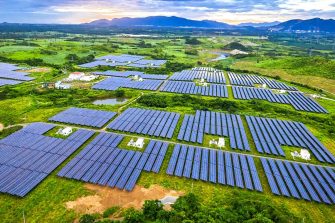Meeting the demand for large-scale energy storage
How vanadium redox flow batteries are changing the way we store energy and provide power.

Share this story
As the adoption of renewable energy continues to increase, so does the need for more efficient and sustainable energy storage. While wind and solar generate affordable electricity, this energy is often intermittent and reliant on significant storage space to avoid outages. The UNSW Vanadium Redox Flow Battery (VRFB) technology however is a safe, easy-to-recycle and low-maintenance option that allows for increased resilience of the energy supply during times of high demand and beyond.
Professor Skyllas-Kazacos and her research team in 1988 with the first laboratory prototype vanadium cell.(Supplied: UNSW/Maria Skyllas-Kazacos). Early Vanadium Battery research team (1988) showing (L-R) Franz Grossmith, Michael Kazacos, Maria and Rodney McDermott with the first laboratory prototype vanadium cell.
Since the invention of the very first all-vanadium redox flow cell by UNSW Professor Maria Skyllas-Kazacos and her team in 1984, the university has been at the forefront of VRFB technology. This work has been especially significant within the context of renewable energy and Australia’s rapid switch to the uptake of net-zero policies.
While wind and solar provide a range of benefits to community and industry alike, they also present their own challenges.
“You can’t have just solar or wind farms because the sun doesn’t shine at night and the wind doesn’t always blow."
- Professor Skyllas-Kazacos
Energy storage however allows users to still enjoy their renewable power systems as needed by ensuring large battery systems remain charged – even during the absence of sunlight during inclement weather.
“With coal fire or gas generators, you can control how much energy you produce, so if that demand goes up – you can produce more but we can’t do that with renewable energy,” says team member Professor Jie Bao. “The key technology that’s required here is energy storage,” he adds. “Vanadium flow batteries are ideal for renewable energy storage since their cost per kWh decreases with increasing storage capacity, making them the cheapest form of energy storage for long duration applications.”
Security of energy supply
Beyond resilience to the actual grid, one of the many advantages of the vanadium battery includes applications that can be used to help off-grid and remote communities store more energy. “Even as recently as during COVID-19, we had a large demand for mobile hospitals and other areas where we couldn’t power them from the hospital grid because there wasn’t enough capacity,” says Associate Professor Chris Menictas. “Having that additional capacity available adds a resilience to these systems.”
What’s more, if the grid fails – energy and power can be taken from the VRFB and placed back into the grid to ensure less disruption and negative impact. “If the electricity transmission system went down, you could have batteries that would help keep that essential infrastructure running,” he adds.
For smaller scale suburban communities looking to bolster their access to power, VRFB also has applications within this context. The batteries can be integrated into a microgrid.
2007 V-Fuel Lab photo showing a 5 kW vanadium battery prototype.
“If the whole neighbourhood had solar panels for example, they wouldn’t need to each have their own battery to charge up, they’d just dump all of their surplus energy into that community battery and get it back at night-time.”
- Professor Skyllas-Kazacos
Importantly, the vanadium battery is a sustainable option that eliminates thermal issues and the risk of fire or explosion. “The vanadium electrolyte has an indefinite life so if the battery is to be decommissioned after 20 years, you can take the electrolyte and put it into another battery,” adds A/Prof. Menictas. “You just keep reusing the electrolyte, which creates minimal waste.”
Professor Skyllas-Kazacos with Dr Menictas and Professor Jens Tübke (far left), in 2018 at a 2MW/20MWh VRFB site at Fraunhofer ICT in Germany. (Supplied: Maria Skyllas-Kazacos).
Future focused
Having provided the foundations for the research and development of vanadium battery production and technology, Prof. Skyllas-Kazacos is happy to see other groups now extending her work and commercialising the research. “This type of industry contribution has allowed for a reduction in cost, which is a major outcome and something we’re also continuing to work on at UNSW.”
As the potential of vanadium battery technology becomes increasingly apparent, Prof. Skyllas-Kazacos and her team would like to see the local production of vanadium batteries and the electrolyte add value through new job and industry opportunities, as well as the extraction and processing of the relevant minerals on home soil.
“From the very beginning when we patented the first battery – my dream was to see vanadium batteries manufactured in Australia. After 40 years of research, I think the time has finally come.”
- Professor Skyllas-Kazacos
Share this story
Read more
Get in touch and see what’s possible.
Ask how we can help your business, industry, or market through collaboration.



